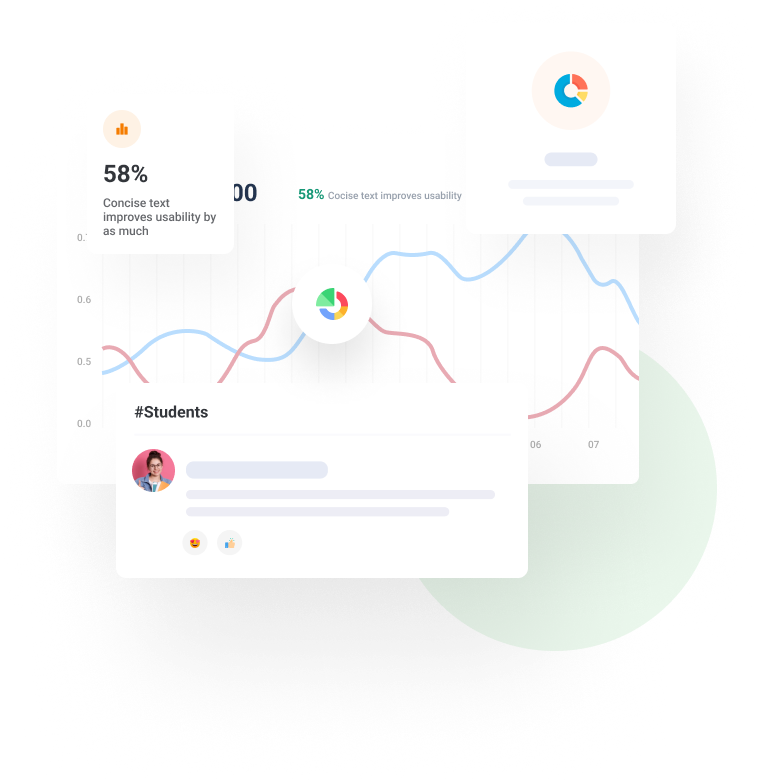Best Practices for Teaching Online – zyBooks Guide
Online teaching exploded during the pandemic, and in years since, it has become even more ubiquitous. But many instructors are still unsure how to best teach their courses and engage students in a virtual environment.
As the director of the content authoring and research team here at zyBooks, and as a former computer engineering professor, I’ve researched online instruction and taught remote courses myself.
From this experience, I’ve distilled key best practices for teaching effectively online that I want to share with you – practices you can apply to your own online classrooms to create a richer and more successful learning experience for your students.
In this post
1. Provide engaging learning material for independent study
2. Connect with students personally, even online
Solve problems with your students
3. Give students ways to connect with each other
4. Keep it simple, predictable, and consistent
1. Provide engaging learning material for independent study
The first and most critical tool for online teaching is using great learning material that students can work on by themselves, without requiring constant guidance from the instructor.
Rely on interactive content
Use interactive content that breaks down complex concepts into simple chunks of information that students can easily digest. Also, use content platforms with built-in activity tracking and auto-grading features, so you can monitor students’ progress remotely and give actionable feedback.
zyBooks is a great example of this. We rely on interactive animations, formative assessments, and coding tools embedded throughout our digital books to help students grasp STEM subjects. We also designed our content to reduce the cognitive load for students and optimize their understanding by keeping things simple and engaging. These points are key.
Tread carefully with videos
Videos have become popular in online courses in the last few years, but I’m wary of this trend for a few reasons. First, you can’t measure whether a student has watched assigned videos. Second, the quality is all over the map; producing a well-executed video is not a simple task! And finally, they’re not interactive, so there’s no way to measure if the student has actually absorbed the video’s information.
2. Connect with students personally, even online
Another key aspect of successful remote teaching is finding ways to personally connect with students. Learning research shows that students thrive when they have a teacher who cares. This human connection is even more critical with online instruction.
Personal stories
I like to start the semester by sharing my own story and background with my students, relating how taking apart a desktop machine with my dad when I was 12 inspired me to become a computer engineer. Stories like these help create an instant connection and rapport with my class.
Solve problems with your students
Once the semester gets underway, I’ll ask my students to come to their online classes with problems for me to solve on the spot, like a game of “stump the professor.” This really clicks with them and we have a lot of fun working through problems together. I’ll ask if anyone has ideas, and students love to contribute and help me get through the challenge.
Online office hours
Finally, I make sure to be available and accessible for my students and schedule fixed online office hours when they can ask questions. If you’re stuck on a lab or an assignment, I’m available to help and support you.
It’s important to take these steps to demonstrate that you care about your students’ learning and success.
3. Give students ways to connect with each other
Giving students ways to connect with each other fosters a sense of community and collaboration, even if they never meet in person.
Discussion boards
Discussion boards are essential to establishing this connection, for three reasons:
- It gives students a forum to ask each other questions, share ideas, even work together on a lab or prepare for an exam.
- It helps me, the instructor, gauge the level of understanding and interest of the class, as I can see what topics or issues are discussed or raised by the students.
- And finally, discussion forums can reduce the pressure or fear of judgment that some students may feel when speaking in front of an entire in-person class, or even one-on-one with me.
Community building
Online forums can make students feel more comfortable and confident to express themselves. But I also help students connect with each other during online class time. When this connection happens, you can feel the shift from an instructor lecturing a class of 50 to an engaged community learning together. That’s the goal.
I’ll employ frequent polls or even play a Kahoot! learning game with the class. I’ll also introduce what I call “weird icebreakers,” like assigning an offbeat article that relates to our class, post it on the discussion board, then discussit during class. For example, we’ve had discussions about the digital logic of self-driving cars, among other topics.
Low-pressure engagement
Counterintuitively, I’ve found that online courses can actually increase student engagement. There seems to be less pressure or fear of judgment for students to speak up online versus in an in-person classroom. So I get more engagement from a lot of students who would ordinarily shy away from contributing to a live environment but feel more comfortable on Zoom.
“Counterintuitively, I’ve found that online courses can actually increase student engagement. There seems to be less pressure or fear of judgment for students to speak up online versus in an in-person classroom.”
Dr. Yamuna Rajasekhar
That’s an underrated advantage to online teaching. I try to encourage this by offering students bonus points for speaking up that they can apply to quiz scores to increase their grades.
4. Keep it simple, predictable, and consistent
Finally, when teaching online, keep it simple, predictable, and consistent for your students. I achieve this in a number of ways:
Consistent cadence
First, I aim to maintain a consistent cadence from one week to the next so students know what to expect in class. This means not changing the format or expectations of the course too often, but rather sticking to a clear and structured plan that students can follow and anticipate.
“Productive struggle”
I also don’t overwhelm or frustrate my students with too much or overly difficult work, but instead I give them small and manageable homework assignments that they can easily accomplish every week. Managing their cognitive load is paramount. You want to encourage students to engage in a “productive struggle” that strengthens their learning but avoids them throwing their hands up in frustration.
“You want to encourage students to engage in a “productive struggle” that strengthens their learning but avoids them throwing their hands up in frustration.”
Dr. Yamuna Rajasekhar
Low-stakes quizzes
Finally, I like to give students low-stakes quizzes every week to help them build their confidence. These quizzes recap the previous week’s lecture. They consist of simple questions that are not tied to a big portion of their grade. The quizzes help me ensure that my students understood the material that I taught – and also help me pace my lectures. If 60% of my students did poorly on a quiz, I know I have to go back and re-teach some concepts.
Final thought…
I hope you find these approaches helpful. Now I want to hear from you! What techniques have you used in your online courses that I haven’t covered but you found particularly useful? Drop me a line at officehours@zybooks.com. I’d love to hear from you.









